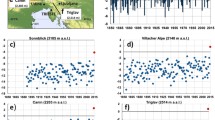Abstract
We investigate an anomalous phenomenon evident in the Miryang Eoreumgol (Ice Valley), Korea: The wind and water are cold during summer and warm during winter, and ice formation does not occur in winter but in summer. We have initiated observations and investigations into the origin of heat sources particularly with regard to the mechanism of ice formation in summer. Previous theories, e.g., concerning underground gravity currents, water evaporation, diurnal and seasonal respirations of the talus, effects of ground heat, radiation and topography, etc., are considered. After a calculation of heat sources, we propose two new concepts—a repetitious heat separation mechanism and a positive feedback mechanism of cold air generation—to demonstrate that the heat mechanism of the seasonal reversal of the ice valley may be controlled by the use of the phase change between ice and water vapor with only a small amount of additional unknown energy.









Similar content being viewed by others
References
Bae SK (1990) Hydrological study on the summer icing in the Ice Valley. J Korean Hydrol Soc 23:459–466
Byun HR, Choi KS, Kim KH, Tanaka HL (2003a) The underground convection on the winter warm wind and summer icing of the Ice Valley. Daegi 13:230–233 (in Korean)
Byun HR, Choi KS, Kim KH, Tanaka HL, Seo DI (2003b) For the increase of ices forming at spring and persisting to summer in the Ice Valley. Daegi 13:376–377 (In Korean)
Byun HR, Choi KS, Kim KH, Tanaka HL (2004) The characteristics and thermal mechanism of the warm wind hole found at the Ice Valley in Mt Jae-Yak. J Korean Meteor Soc 40:453–465 (in Korean with English abstract)
Byun HR et al (2006) Study on the mechanism of the summer-time icing on the Ice-Valley. Miryang city, Korea, 402pp (in Korean)
Chepil WS (1945) Dynamics of wind erosion III: the transport capacity of the wind. Soil Sci 60:475–480
Cho HK (1969) Estimation of evaporation by using a simple empirical mass-transfer method. J Korean Meteor Soc 5:3–9 (in Korean with English abstract)
Han JS, Lee BS (2005) Measurement and analysis of free water evaporation at Haenam paddy field. Korean J Agricultural Forest Meteor 7:92–98
Hong SH, Choi PY (1988) Explanatory note of the Yucheon sheet (1:50,000). Korea Institute of Energy and Resources, Seoul, 26 pp
Jung CH (1992) The inspection report on the natural monument and the put-step of the dinosaurs. The study on the Ice Valley Miryang Nammyeong-ri. Korean Geolog Soc 61–84:200 (in Korean)
Kim SS (1968) On the cause of the summer icing in the Ice Valley (Miryang). J Korean Meteo Soc 4:13–18 (in Korean with English Abstract)
Luetscher M, Jeannin PY (2004) A process-based classification of alpine ice caves. Theor Appl Karstol 17:5–10
Luetscher M, Lismonde B, Jeannin PY (2008) Heat exchanges in the heterothermic zone of a karst system: Monlesi cave, Swiss Jura Mountains. J Geophys Res 113:F02025. doi:10.1029/2007JF000892
Moon SE, Whang SJ (1977) The study on the summer icing of the Miryang Ice Valley. Paper collections of Busan University, Vol. 4, Part of Natural Sciences, pp 47–57 (in Korean)
Ohata T, Furukawa T, Higuchi K (1994) Glacioclimatological study of perennial ice in the Fuji ice cave, Japan. Part 1. Seasonal variation and mechanism of maintenance. Arct Alpine Res 26:227–237
Penman HL (1948) Natural evaporation from open water, bare soil and grass. Proc Roy Soc London 193A:120–146
Persoiu A, Feier I, Citterion M, Turri S, Maggi V (2007) Preliminary data on air temperature in Focul Viu ice cave (Bihor Mts, Romania). Proceedings of the 2nd International Workshop on Ice Caves, Liptovsky-Mikulas, Slovakia, pp 62–64
Pflitsch A, Piaseki J (2003) Detection of an airflow system in Niedzwiedzia (Bear) cave, Klento, Poland. J Caves Karst Stud 65:160–173
Pflitsch A, Piasecki J, Sawinski T, Strug K, Zelinka J (2007) Development and degradation of ice crystals sediment in Dobsinska ice cave. Proceedings of the 2nd International Workshop on Ice Caves. Liptovsky-Mikulas, Slovakia, pp 38–49
Piasecki J, Sawinski T, Strug K, Zelinka J (2007) Selected characteristics of the micro climate of the Demanovsca ice cave (Slovakia). Proceedings of the 2nd International Workshop on Ice Caves. Liptovsky-Mikulas, Slovakia, pp 50–61
Song TH (1994) Numerical simulation of seasonal convection in an inclined talus. Proceedings of the 10th International Heat Transfer Conference 2, pp 455–460
Tanaka HL (1997) The numerical experiment on the summer icing on the Miryang Korea. Jirihak-Pyeongron 70(A):1–14 (in Japanese)
Tanaka HL, Nohara D, Yokoi M (2000) Numerical simulation of the wind-hole circulation and summertime ice formation at Ice Valley in Korea and Nakayama in Fukushima, Japan. J Meteorol Soc Jpn 78:611–630
Tanaka HL, Nohara D, Byun HR (2006) Numerical simulation of wind-hole circulation at ice valley in Korea using a simple 2D model. J Meteorol Soc Jpn 84:1073–1084
Vrana K, Baker J, Clausen HB, Hansen SB, Zelinka J, Rufli H, Ockaik L, Janocko J (2007) Continental ice body in Donsina ice cave—part I. Project and sampling phase of isotopic and chemical study. Proceedings of the 2nd International Workshop on Ice Caves, Liptovsky-Mikulas, Slovakia, pp 24–29
Whang SJ, Seo KS, Lee SH (2005) Study on ice formation mechanism at the Ice Valley in Milyang, Korea. J Korean Meteo Soc 41:29–40
Acknowledgments
This work was funded by the Korea Meteorological Administration Research and Development Program under Grant CATER 2006-2306.
Author information
Authors and Affiliations
Corresponding author
Rights and permissions
About this article
Cite this article
Byun, HR., Tanaka, H.L., Choi, Py. et al. Seasonal reversal at Miryang Eoreumgol (Ice Valley), Korea: observation and monitoring. Theor Appl Climatol 106, 403–415 (2011). https://doi.org/10.1007/s00704-011-0429-5
Received:
Accepted:
Published:
Issue Date:
DOI: https://doi.org/10.1007/s00704-011-0429-5



